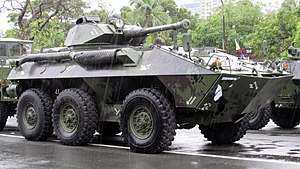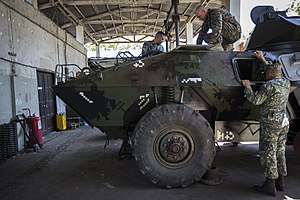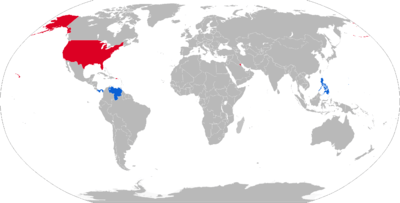LAV-300
The Cadillac Gage LAV-300, originally named the V-300,[2] is a family of American light armored vehicles (LAVs) including up to 15 configurations. It was originally created and designed by CG as a private venture project.[3]
| LAV-300 | |
|---|---|
 A Cadillac Gage LAV-300 (Light Armored Vehicle) of the Philippine Marine Corps | |
| Type | Light Armored Vehicle |
| Place of origin | United States |
| Service history | |
| In service | 1979 – present |
| Used by | See Operators |
| Wars | |
| Production history | |
| Manufacturer | Cadillac Gage |
| Unit cost | $USD562,900 (2003)[1] |
| Produced | 1983-1994 |
| No. built | 103[1] |
| Variants | See Variants |
| Specifications | |
| Mass | 14,696 kg. |
| Length | 6.40 m |
| Width | 2.54 m |
| Height | 2.7 m (turret roof), 1.98 m (hull top) |
| Crew | 3 (Crew) + 9 (Passengers) |
| Armor | Protects against 7.62mm ammunition. |
Main armament | 1 x 90 mm, 1 x 7.62 mm Machinegun |
Secondary armament | 2x6 40 mm Smoke Dischargers |
| Engine | Cummins 6 CTA 8.3 diesel turbo charged engine 260 bhp |
| Power/weight | 18.36 bhp/ton |
| Suspension | 6 x 6 |
Operational range | 925 km |
| Maximum speed | 105 km/h (road), 3 km/h (water) |
As of 2020, the vehicle and its derivatives are no longer being marketed by Textron.
History
The first country to buy it was Panama, which purchased 12 to 13 LAV-300s[4] in APC, Fire Support Vehicle and Armored Recovery variants.[5][2] Most of them were captured by American forces during Operation Just Cause.[2] In Panama Defense Forces services, they were used by the 5th Infantry Company, the 6th Infantry Company (Mechanized) and Battalion 2000 (Mechanized).[5] 4 LAV-300s were used by the 6th Infantry Company while 9 were used by Battalion 2000.[5] They were deployed during the Battle of Paitilla Airport to block the path of the SEALS deployed to destroy Noriega's private aircraft.[6]
Kuwait placed an order in 1984 for 62 vehicles, some of them in FSV configuration.[1] Most of Kuwait's LAV-300s were destroyed by Iraqi troops during the 1990 Invasion of Kuwait.[7]
When production of the vehicle was reorganized and placed at New Orleans, its name changed from the V-300 to the LAV-300 in 1994.[1]
The Philippines placed an order in 1993 for 24 LAV-300 MK IIs, 12 in APC configuration and 12 in FSV configuration, which were delivered by 1995.[2] The contract was worth $USD18.243 million.[1] LAV-300s used by the Philippine Marine Corps were designed to be equipped with the .50 BMG/7.62mm NATO turret for the APC and the 90mm Cockerill 90mm gun for the FSV.[8]
In a 1994 report by Natick from January to September 1993, the LAV-300 was once considered to be a suitable candidate for the US Army Military Police Armored Security Vehicle program.[9] In 1999, the LAV-300 was considered alongside the LAV-600 to be selected for the US Army's Brigade Combat Team.[2] In the same year, an infantry fighting vehicle version of the LAV-300 MK II was tested at Fort Knox for potential deployment with rapid reaction forces before the Stryker was chosen instead.[1] This proposal was even backed by Captain David L. Nobles in his proposal due to low economical expenses needed to maintain the LAV-300.[10]
Production of the LAV-300 ended in 1994 with marketing discontinued by 2000.[11]
In 2008, Cobb County Police Department has reported the purchase of a LAV-300 for $500,000 with $45,000 to $51,000 paid to refurbish the vehicle for police use.[12][13] The vehicle was acquired by the CCPD through the 1033 program from Fort Polk, Louisiana.[13]
In 2010, Federal Defense Industries announced that they entered into an agreement with Textron Marine & Land Systems in order to provide authorized aftermarket parts, support and other types of assistance for the LAV-300 since FDI maintains a technical library for spare parts.[14]
In 2011, Napco entered into an agreement with Textron to provide authorized aftermarket parts, support and other types of assistance for the LAV-300.[15]
On October 5, 2018, the Philippine Department of National Defense launched a bid to upgrade armored vehicles of the Philippine Navy and Air Force under the Light Armor System Upgrade (LARSU) Acquisition Project with a budget of PHP711,938,000.00.[16] On November 28, 2018, the DND released a bid requirement for a company to modernize the LAV-300s still in working condition with the PMC.[17]
On January 10, 2019, Larsen & Toubro was awarded a contract for $US 14 million for the Armed Forces of the Philippines' Light Armor System Upgrade in replacing worn out engines and other parts.[18]
Design

The LAV-300 has a seating capacity for three crewmembers, consisting of a driver, commander and gunner,[19] and nine passengers.[20] Its weight is at 14,696 kg. with a length of 6.40 m and width of 2.54 m.[21] The height is at 2.7 m with a turret and at 1.98 m to the hull.[3] It can go up to 105 km/hr under a range of 925 km.[21]
It offers high mobility, speeds of up to 65 mph (105 km/h), and can be air-transported by a C-5 Galaxy, C-141 Starlifter, C-17 Globemaster III and a C-130 Hercules cargo aircraft.[20] Some versions can be air-transported by CH-53E Super Stallion helicopter.[20]
Armor
The LAV-300's armor is composed of high-hardness Cadloy steel armor employed on a minimum silhouette hull capable of withstanding 7.62 mm caliber bullets at point-blank range from any angle.[8][21] Additional armor of the vehicle's floor can protect the crew from grenades and landmines.[8] Survivability is further enhanced from low observable technology to minimize levels of thermal, seismic and audio signatures, and minimal radar return.[8]
Maneuverability
The LAV-300 is amphibious with no need for preparation for fording.[3]
Highly mobile, the LAV-300 MK II is also fully amphibious with no need for preparation for fording and swimming.[8] The tires are radial tubeless and can be outfitted with run-flat inserts and a central tire inflation system for enhanced mobility.[8] It can climb a 60 percent gradient, operate on a 30 percent side slope, and tackle two-foot-high obstacles.[8]
Engine
The LAV-300 uses a Cummins VT-504 270-hp liquid cooled turbocharged V-8 diesel engine.[8][2]
The LAV-300 MK II's turbocharged diesel engine allows for acceleration from 0 to 32 km/h in less than 10 seconds.[8] It can use Jet-A fuel, kerosene and other lighter fuels in case of a lack of diesel fuel.[8] The six-wheel, dual hydraulic brakes permit the vehicle to go from 20 miles per hour to 0 in approximately 12 m with its operating range at 925 km.[8] The suspension is composed by a 6x6 wheels (6 driving wheels- 2 wheel steering front axle has solid beam on trailing arms. Rear axles have independent trailing arm with coil springs and 1 shock absorber.[8] It also has a tranmission of 6 forward and 2 reverse gears.[2]
Variants
The LAV-300 has fifteen different configurations—the most common being: command post, armored personnel carrier, anti-tank, military logistics, ambulance and armored recovery vehicle.[2][3]
The following turrets are available for the LAV-300:[2][8][1]
- 7.62 mm machine gun combined with 12.7 mm, 25 mm, 30 mm or 40 mm guns
- 20 mm anti-aircraft gun
- Missile-based anti-aircraft system
- BGM-71 TOW anti-tank guided missile
- 90 mm gun
- 81 mm and 120 mm mortars.
LAV-300 MK II
An improved version of the LAV-300, known as the LAV-300 MK II was developed in the 1980s with an aftercool type engine, improved transmission with 6 forward and 2 gear ratio with better tires and a larger fuel tank.[2] An infantry fighting vehicle variant was made as part of the MK II.[1]
LAV-300A1
A variant of the LAV-300 equipped with a turret from the Stingray light tank.[2][1] It's later designated as the LAV-600.[1]
Operators

Current operators


Former operators
References
- "V-300/V-600 Commando - Archived 8/2004". Forecastinternational.com. Retrieved 30 July 2017.
- Pike, John. "LAV-300/LAV-600". Globalsecurity.org. Archived from the original on 23 July 2019. Retrieved 30 July 2017.
- Foss, page 392.
- https://www.loc.gov/resource/frdcstdy.panamacountrystu00medi/?q=caribbean&sp=277&st=text
- Rottman, Page 14.
- "Special Operations Highlighted the Early Hours of Operation Just Cause". SOFREP.
- Laur, Colonel Timothy (1995). Encyclopedia of Modern US Military Weapons. New York: Berkley Publishing Corporation. ISBN 978-0425147818.CS1 maint: ref=harv (link)
- "LAV-300 V-300 Cadillac Cage Textron light wheeled armoured vehicle US army United States pictures te". Armyrecognition.com. 14 July 2013. Retrieved 7 March 2020.
- "Wayback Machine" (PDF). web.archive.org. 7 March 2020. Archived from the original (PDF) on 7 March 2020.
- https://web.archive.org/web/20170201160230/https://www.benning.army.mil/armor/eARMOR/content/issues/1990/MAY_JUN/ArmorMayJune1990web.pdf
- John Pike. "LAV-150 Commando". globalsecurity.org. Archived from the original on 23 July 2019. Retrieved 14 March 2020.
- "Cobb police add tank to arsenal | ajc.com". web.archive.org. 16 October 2008. Archived from the original on 16 October 2008.
- "Department History". Cobb County Georgia.
- https://web.archive.org/web/20190615075157/https://www.fdi.us.com/cadillac-gage
- http://www.napcointl.com/Napco%20General%20Presentation.pdf
- "Philippines: PHL awarded contract to upgrade light armored vehicles". Army Recognition. 5 October 2018.
- NR DND-PN-PAF-LARSU-18-R-03.pdf
- "Indian company to take care of Light Armor System Upgrade project for the Philippines". Navy Recognition. 10 January 2019.
- https://web.archive.org/web/20170420011648/http://www.globalsecurity.org/military/systems/ground/lav-300-specs.htm
- "LAV-300". Deagel.com. Retrieved 30 July 2017.
- "LAV-300 Cadillac Gage Textron Light armoured vehicle". Army Recognition. Retrieved 17 March 2016.
- "Philippine Marine Corps". www.globalsecurity.org.
- "FIC to Overhaul V150 LAV". web.archive.org. 2 May 2002. Archived from the original on 2 May 2002.
- "Armor Update". pmcmssr.tripod.com.
- ngain. "Philippine Marine Corps to upgrade turrets of its armored fighting vehicles - February 2015 Global Defense Security news UK - Defense Security global news industry army 2015 - Archive News year". www.armyrecognition.com.
- "Small-Town Cops Pile Up on Useless Military Gear | WIRED". web.archive.org. 18 February 2020. Archived from the original on 18 February 2020.
- "Former Equipment of Iraqi Army". Archive.org. Retrieved 17 July 2018.
- Yates, page 211.
Bibliography
| Wikimedia Commons has media related to LAV-300. |
- Foss, Christopher F. (2000), Jane's Tank and Combat Vehicle Recognition Guide (Second Edition), HarperCollins, ISBN 0-00-472452-6
- Rottman, Gordon L. (2010), Panama 1989-1990, Osprey Publishing, ISBN 978-1855321564